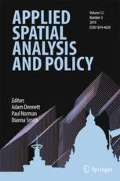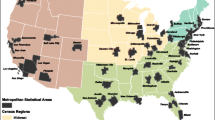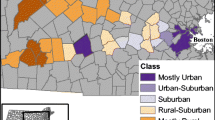Abstract
In this paper we investigate the regional variations in the fragmentation of urban landcover among 86 metropolitan areas and 19 megapolitan areas in the United States. Urban fragmentation was evaluated using nine spatial metrics that collectively quantified the continuity and shape complexity of urban landcover. Spatial metrics were calculated for each metropolitan and megapolitan area using a high urban threshold containing the urban core and surrounding suburbs, and a low urban threshold that further encompassed the outer exurban fringe. A principal component analysis was used to collapse the nine spatial metrics into two components of urban form: “shape complexity”, which describes the porosity of the urban fabric, and urban “continuity”, which represents the aggregation of urban patches or pixels. Urban “continuity”, and seven of nine spatial metrics, varied significantly by U.S. census region. A hot-spot analysis further revealed a high degree of spatial autocorrelation, with metropolitan areas in the Northeast and South regions generally exhibiting a more fragmented urban landscape than those in the Midwest or West regions. Relative to metropolitan areas, megapolitan areas exhibited more complex and fragmented patterns of urban landcover, presumably due to the high level of inter- and intra-urban polycentricism at this broader scale.









Similar content being viewed by others
References
Aguilera, F., Valenzuela, L. M., & Botequilha-Leitao, A. (2011). Landscape metrics in the analysis of urban land use patterns: a case study in a Spanish metropolitan area. Landscape and Urban Planning, 99, 226–238.
Alexander, D., & Tomalty, R. (2002). Smart growth and sustainable development: challenges solutions and policy directions. Local Environment, 7(4), 397–409.
Anderson, J. R., Hardy, E. E., Roach, J. T., & Witmer, R. E. (1976). A land use and land cover classification system for use with remote sensor data. Arlington: U.S. Geological Survey.
Bengston, D. N., Fletcher, J. O., & Nelson, K. C. (2004). Public policies for managing urban growth and protecting open space: policy instruments and lessons learned in the United States. Landscape and Urban Planning, 69, 271–286.
Bereitschaft, B. (2008). Spatial-temporal distribution of tropospheric ozone in the Carolina Piedmont megapolitan area. The North Carolina Geographer, 16, 49–59.
Berke, P. R. (2002). Does sustainable development offer a new direction for planning? Challenges for the 21st century. Journal of Planning Literature, 17(1), 21–36.
Bhatta, B., Saraswati, S., & Bandyopadhyay, D. (2010). Urban sprawl measurement from remote sensing data. Applied Geography, 30(4), 731–740.
Borrego, C., Martins, H., Tchepel, O., Salmim, L., Monteiro, A., & Miranda, A. I. (2006). How urban structure can affect city sustainability from an air quality perspective. Environmental Modelling and Software, 21, 461–467.
Brown, D. G., Johnson, K. M., Loveland, T. R., & Theobald, D. M. (2005). Rural land-use trends in the conterminous United States. Ecological Applications, 15, 1851–1863.
Bruegmann, R. (2006). Sprawl: A compact history. Chicago: University of Chicago Press.
Bullard, R. D., Johnson, G. S., & Torres, A. O. (2000). Sprawl city: Race, politics and planning in Atlanta. Washington, D.C.: Island Press.
Burchfield, M., Overman, H. G., Puga, D., & Turner, M. A. (2006). Causes of sprawl: a portrait from space. Quarterly Journal of Economics, 121(2), 587–633.
Burton, E. (2002). Measuring urban compactness in UK towns and cities. Environment and Planning B: Planning and Design, 29(2), 219–250.
Carruthers, J. I., & Ulfarsson, G. F. (2003). Urban sprawl and the cost of public services. Environment and Planning B: Planning and Design, 30, 503–522.
City of Sacramento. (2002). City of Sacramento infill strategy. http://www.cityofsacramento.org/dsd/planning/division-infill/documents/infill-strategy.pdf. Accessed November 21 2011.
Daniels, T. (2001). Smart growth: a new American approach to regional planning. Planning Practice and Research, 16(3/4), 271–279.
El-Nasser, H., & Overberg, P. (2001). A comprehensive look at sprawl in America. USA Today, 1A, 6A–9A.
Elvidge, C. D., Baugh, K. E., Kihn, E. A., Kroehl, H. W., & Davis, E. R. (1997). Mapping of city lights using DMSP Operational Linescan System data. Photogrammetric Engineering & Remote Sensing, 63, 727–734.
Elvidge, C. D., Baugh, K. E., Dietz, J., Bland, T., Sutton, P. C., & Kroehl, H. W. (1999). Radiance calibration of DMSP-OLS low-light imaging data of human settlements. Remote Sensing of Environment, 68(1), 77–88.
Ewing, R. (2008). Characteristics, causes, and effects of sprawl: a literature review. Environmental and Urban Studies, 2(2), 1–15.
Ewing, R., Pendall, R., & Chen, D. (2002). Measuring sprawl and its impacts. Smart Growth of America. http://www.smartgrowthamerica.org/sprawlindex/sprawlindex.html. Accessed June 3 2011.
Ewing, R., Pendall, R., & Chen, D. (2003a). Measuring sprawl and its transportation impacts. Transportation Research Record, 1831, 175–183.
Ewing, R., Schmid, T., Killingsworth, R., Zlot, A., & Raudenbush, S. (2003b). Relationship between urban sprawl and physical activity, obesity, and morbidity. American Journal of Health Promotion, 18, 47–57.
Ewing, R., Brownson, R. C., & Berrigan, D. (2006). Relationship between urban sprawl and weight of United States youth. American Journal of Preventative Medicine, 3(16), 464–474.
Frank, L. D., Sallis, J. F., Conway, T. L., Chapman, J. E., Saelens, B. E., & Bachman, W. (2006). Many pathways from land use to health: associations between neighborhood walkability and active transportation, body mass index, and air quality. Journal of the American Planning Association, 72, 75–87.
Frumpkin, H. (2002). Urban sprawl and public health. Public Health Reports, 117(3), 201–217.
Fulton, W., Pendall, R., Nguyen, M., & Harrison, A. (2001). Who sprawls the most? How growth patterns differ across the United States. Washington, D.C.: The Brookings Institution.
Galster, G., Hanson, R., Ratcliffe, M. R., Wolman, H., Coleman, S., & Freihage, J. (2001). Wrestling sprawl to the ground: defining and measuring an elusive concept. Housing Policy Debate, 12(4), 681–717.
Garreau, J. (1991). Edge city: Life on the new frontier. New York: Doubleday.
Getis, A., & Ord, J. K. (1992). The analysis of spatial association by use of distance statistics. Geographical Analysis, 24(3), 189–206.
Godschalk, D. R. (2004). Land use planning challenges: coping with conflicts in visions of sustainable development and livable communities. Journal of the American Planning Association, 70(1), 5–13.
Grimm, N. B., Faeth, S. H., Golubiewski, N. E., Redman, C. L., Wu, J., Bai, X., et al. (2008). Global change and the ecology of cities. Science, 319, 756–760.
Herold, M., Scepan, J., & Clarke, K. C. (2002). The use of remote sensing and landscape metrics to describe structures and changes in urban land uses. Environment and Planning A, 34, 1443–1458.
Herold, M., Goldstein, N. C., & Clarke, K. C. (2003). The spatiotemporal form of urban growth: measurement, analysis and modeling. Remote Sensing of Environment, 86, 286–302.
Homer, C., Dewitz, J., Fry, J., Coan, M., Hossain, N., Larson, C., et al. (2007). Completion of the 2001 National Land Cover Database for the Conterminous United States. Photogrammetric Engineering and Remote Sensing, 73(4), 337–341.
Huang, J., Lu, X. X., & Sellers, J. M. (2007). A global comparative analysis of urban form: applying spatial metrics and remote sensing. Landscape and Urban Planning, 82, 184–197.
Ingram, G. K., Carbonell, A., Hong, Y., & Flint, A. (2009). Smart growth policies: An evaluation of programs and outcomes. Cambridge: Lincoln Institute of Land Policy.
Jabareen, Y. R. (2006). Sustainable urban forms: their typologies, models and concepts. Journal of Planning Education and Research, 26, 38–52.
Jaeger, J., Bertiller, R., Schwick, C., & Kienast, F. (2010). Suitability criteria for measures of urban sprawl. Ecological Indicatory, 10, 397–406.
Jenerette, G. D., & Wu, J. (2001). Spatiotemporal changes of landscape pattern in response to urbanization. Landscape and Urban Planning, 81, 341–353.
Ji, W., Ma, J., Twibell, R. W., & Underhill, K. (2006). Characterizing urban sprawl using multi-stage remote sensing images and landscape metrics. Computers, Environment and Urban Systems, 30, 861–879.
Jiang, F., Liu, S., & Zhang, Q. (2007). Measuring urban sprawl in Beijing with geo-spatial indices. Journal of Geographic Sciences, 17(4), 469–478.
Kasanko, M., Barredo, J. I., Lavalle, C., McCormick, N., Demicheli, L., Sagris, V., et al. (2006). Are European cities becoming dispersed? A comparative analysis of 15 European urban areas. Landscape and Urban Planning, 77(1–2), 111–130.
Kirshen, P., Ruth, M., & Anderson, W. (2008). Interdependencies of urban climate change impacts and adaptation strategies: a case study of Metropolitan Boston USA. Climate Change, 86, 105–122.
Lang, R. (2006). Megapolitan America. new metropolis lecture series. September 6, Alexandria, VA. http://www.drcog.org/documents/Megapolitan%20Areas%20Robert%20Lang.pdf Accessed January 20 2012.
Lang, R. E., & Knox, P. L. (2009). The new metropolis: rethinking megalopolis. Regional Studies, 43(6), 789–802.
Lang, R. E., & Nelson, A. C. (2007). America 2040: the rise of the megapolitans. American Planning Association. January, 73(1), 7–12.
Li, F., Wang, R., Paulussen, J., & Xusheng, L. (2005). Comprehensive concept planning of urban greening based on ecological principles: a case study in Beijing, China. Landscape and Urban Planning, 72, 325–336.
Longley, P. A., & Mesev, V. (2000). On the measurement and generalization of urban form. Environment and Planning A, 32(3), 473–488.
Lopez, R., & Hynes, H. P. (2003). Sprawl in the 1990s: measurement, distribution and trends. Urban Affairs Review, 38(3), 325–355.
Luck, M., & Wu, J. (2002). A gradient analysis of urban landscape pattern: a case study from the Phoenix metropolitan region, Arizona, USA. Landscape Ecology, 17, 327–339.
McDonald, J. F. (2009). Calibration of a monocentric city model with mixed land use and congestion. Regional Science and Urban Economics, 39(1), 90–96.
McGarigal, K., & Marks, B. J. (1995). FRAGSTATS: spatial pattern analysis program for quantifying landscape structure. General Technical Report PNW-GTR-351, USDA Forest Service, Pacific Northwest Research Station.
McGarigal, K., Cushman, S. A., Neel, M. C., & Ene, E. (2002). FRAGSTATS: spatial pattern analysis program for categorical maps. Computer software program produced by the authors at the University of Massachusetts, Amherst.
McMillen, D. P., & Lester, T. W. (2003). Evolving subcenters: employment and population densities in Chicago, 1970–2020. Journal of Housing Economics, 12(1), 60–81.
Morris, D. E. (2005). It’s a sprawl world after all. Gabriola Island: New Society Publishers.
Muller, P. O. (2004). Transportation and urban form: Stages in the spatial evolution of the American metropolis. In S. Hanson (Ed.), The geography of urban transportation (3rd ed., pp. 59–85). New York: The Guilford Press.
Ndubisi, F. (2008). Sustainable regionalism: evolutionary framework and prospects for managing metropolitan landscapes. Landscape Journal, 27, 1–8.
Nelson, A. C. (2004). Urban containment American style: A preliminary assessment. In C. B. Chang-Hee, H. W. Richardson, & C. C. Bae (Eds.), Urban sprawl in Western Europe and the United States (pp. 237–254). Aldershot: Ashgate Publishing.
Nelson, A. C., & Sanchez, T. W. (2005). The effectiveness of urban containment regimes in reducing exurban sprawl. DISP, 160, 42–47.
OMB (2008). OMB Bulletin No. 09–01, Executive Office of the President, Office of Management and Budget, Washington, D.C. http://www.whitehouse.gov/sites/default/files/omb/assets/omb/bulletins/fy2009/09-01.pdf. Accessed March 3 2011.
Ramachandra, T. V., Bharath, H. A., & Sreekantha, S. (2012). Spatial metrics based landscape structure and dynamics assessment for an emerging Indian megalopolis. International Journal of Advanced Research in Artificial Intelligence, 1(1), 48–57.
Schneider, A., & Woodcock, C. E. (2008). Compact, dispersed, fragmented, extensive? A comparison of urban growth in twenty-five global cities using remotely sensed data, pattern metrics and census information. Urban Studies, 45(3), 659–692.
Schwarz, N. (2010). Urban form revisited – selecting indicators for characterising European cities. Landscape and Urban Planning, 96, 29–47.
Seto, K. C., & Fragkias, M. (2005). Quantifying spatiotemporal patterns of urban land–use change in four cities of China with time series landscape metrics. Landscape Ecology, 20(7), 871–888.
Sha, M., & Tian, G. (2010). An analysis of spatiotemporal changes of urban landscape pattern in Phoenix metropolitan region. Procedia Environmental Sciences, 2, 600–604.
Song, Y., & Knapp, G. J. (2004). Measuring urban form: is Portland winning the war on sprawl? Journal of American Planning Association, 70(20), 210–225.
Stone, B. (2008). Urban sprawl and air quality in large US cities. Journal of Environmental Management, 86, 688–698.
Stone, B., & Bullen, J. (2006). Urban form and watershed management: how zoning influences residential stormwater volumes. Environment and Planning B: Planning and Design, 33, 21–37.
Sutton, P. C. (2003). A scale-adjusted measure of “urban sprawl” using nighttime satellite imagery. Remote Sensing of Environment, 86, 353–369.
Sutton, P. C., Cova, T. J., & Elvidge, C. D. (2006). Mapping “exurbia” in the conterminous United States using nighttime satellite imagery. Geocarto International, 21(2), 39–45.
Sutton, P. C., Goetz, A. R., Fildes, S., Forster, C., & Ghosh, T. (2010). Darkness on the edge of town: mapping urban and peri-urban Australia using nighttime satellite imagery. The Professional Geographer, 62(1), 119–133.
Torrens, P. M. (2008). A toolkit for measuring sprawl. Applied Spatial Analysis and Policy, 1, 5–36.
Torrens, P. M., & Alberti, M. (2000). Measuring sprawl. Centre for advanced spatial analysis, Working Paper Series, Paper 27.
U.S. Census Bureau. (2005). Population change in metropolitan and micropolitan areas: 1990–2003. Washington, D.C: U.S. Department of Commerce, Economics and Statistics Administration, U.S. Census Bureau.
U.S. EPA. (2012). Growing for a sustainable future: Miami-Dade county urban development boundary assessment. Washington, D.C.: Smart Growth Program, Office of Sustainable Communities, U.S. Environmental Protection Agency.
Waddell, P., Gudmundur, F. U., Franklin, J. P., & Lobb, J. (2007). Incorporating land use in metropolitan transportation planning. Transportation Research Part A, 41, 382–410.
Weng, Y. (2007). Spatiotemporal changes of landscape pattern in response to urbanization. Landscape and Urban Planning, 81, 341–353.
Wickham, J. D., Stehman, S. V., Fry, J. A., Smith, J. H., & Homer, C. G. (2010). Thematic accuracy of the NLCD 2001 land cover for the conterminous United States. Remote Sensing of Environment, 114(6), 1286–1296.
Wu, J., Jenerettee, G. D., Buyantuyev, A., & Redman, C. L. (2011). Quantifying spatiotemporal patterns of urbanization: the case of the two fastest growing metropolitan regions in the United States. Ecological Complexity, 8(1), 1–8.
Yang, X. (2002). Satellite monitoring of urban spatial growth in the Atlanta metropolitan area. Photogrammetric Engineering & Remote Sensing, 68(7), 725–734.
Ziegler, K. E. (2009). The case for megapolitan growth management in the 21st century: regional urban planning and sustainable development in the United States. The Urban Lawyer, 41(1), 147–182.
Author information
Authors and Affiliations
Corresponding author
Appendix
Appendix
Rights and permissions
About this article
Cite this article
Bereitschaft, B., Debbage, K. Regional Variations in Urban Fragmentation Among U.S. Metropolitan and Megapolitan Areas. Appl. Spatial Analysis 7, 119–147 (2014). https://doi.org/10.1007/s12061-013-9092-9
Received:
Accepted:
Published:
Issue Date:
DOI: https://doi.org/10.1007/s12061-013-9092-9




